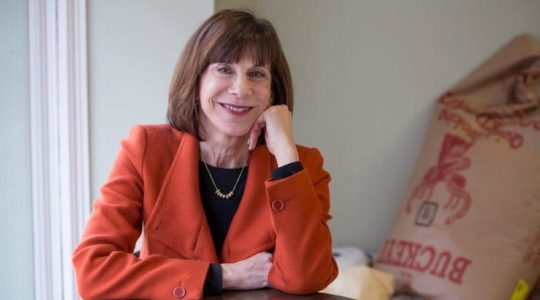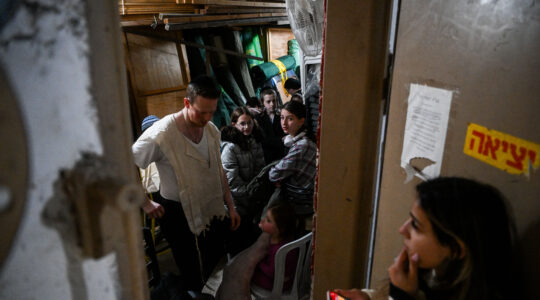TEL AVIV (JTA) — Levana, an unemployed 32-year-old single mother, is eight months pregnant with her third child and seems to owe money to everyone — friends, the government, grocers at the local outdoor produce market where she has bought hundreds of shekels worth of food on credit. “It’s a really hard existence,” said Levana, who is divorced. “The kids want things that I simply cannot provide. This winter I could not afford new shoes for the children.”But she added, offering a thin smile: “Luckily my daughter and I now wear the same size, so at least we can share.”Her family recently cut off contact with Levana after she accused her father of sexually abusing her 10-year-old daughter. He is serving time in jail for the crime. On a recent afternoon her neighbor, Yaffa Ezra, 38, joined her for a visit. She was married at 16, divorced at 18. Until recently she lived across the street with her two grown sons. The older has a long police rap sheet; the younger has picked a straighter path but has yet to find a steady job. Levana and Ezra are part of the fabric of hard times and cohesiveness that make up Shechunat Hatikvah in south Tel Aviv, one of the poorest neighborhoods in the country, where about half of the families live in poverty. The neighborhood represents one of the toughest tests for poverty fighters — a place where generation after generation is entangled in a cycle of poverty. As recent immigrants move in, they also struggle to find their way out of unemployment or low-paying jobs.Shechunat Hatikvah faces similar problems as the deeply impoverished communities in more outlying parts of the country, the heavily immigrant development towns. In the southern development town of Kiryat Malachi for example, multiple soup kitchens have opened, but not new industry and jobs.Anti-poverty activists and residents say the situation of many of these towns are the result of decades of government neglect and poor planning — places seen as dumping grounds where immigrants were settled in demographically strategic locations but far from job opportunities. Shechunat Hatikvah is located in an area that once was lush with orange groves. In their place now stand dilapidated low-rise apartment buildings and narrow alleyways. Laundry is hung from outdoor balconies, paint often peels off living-room walls and families save money by not putting on the heat, even during cold winter nights. The neighborhood is mostly a mix of descendants of the original Iraqi, Iranian and Yemenite families that first settled here in the early 1950s, as well as recent immigrants from the Caucasus Mountains and Uzbekistan. The new immigrants comprise about 40 percent of Shechunat Hatikvah.It’s home as well to others drawn by the cheap rents, including foreign workers from the Philippines and Africa. Rounding out the eclectic mix are about 40 Palestinian families who were settled here by the government after they became informers in the West Bank and Gaza. Teenagers who dropped out or were kicked out of the army congregate on the corners of the neighborhood’s main shopping street, Rehov Etzel, where they eat lamb kebabs or plan where they will meet for a party later the same night. A store that sells lottery tickets bustles with men filling in numbers on stacks of tickets, hoping the right combination will change their luck. A foreign worker from Africa, fresh from the outdoor market, pushes home bags of fruit and vegetables in a baby stroller. Nearby, retired men play backgammon while grilling meat for dinner on a portable barbecue. Amid the bustle, an elderly man and woman collect empty bottles and push them in carts up the street, hoping to collect a few cents for each one. Taking in the evening scene is Ezra’s younger son, Ben, 20. Since his mother rented out their home to help makes ends meet, he sleeps at the apartments of friends, but wonders if he will find a place of his own. He has been arrested several times, mostly for fights, but he says all of that is in the past. Ben Ezra, who has cropped dark hair, three tattoos and wears two hoop earrings, calls himself “The King of the Neighborhood.” Indeed, he seems to know almost everyone, waving a personal greeting to almost everyone he passes. He now volunteers at a local program for at-risk youth called Better Together, where he tries to act as a role model, steering others in the neighborhood away from despair and in some cases a life of crime. He is still shaken from the experience of recently helping talk three teens out of killing themselves in the space of a few weeks.Sponsored by the American Jewish Joint Distribution Committee, Better Together operates in several of the most socioeconomically challenged neighborhoods in Israel. It tries to help youth-oriented organizations — schools, welfare offices and community centers — better coordinate their work and pool their resources more effectively. Better Together, which advocates an expansive and holistic approach to rehabilitating the Israeli underclass, focuses on children from the very beginning of their lives as members of both a family and a community. More than half of the children here between ages 3 and 6 need help with motor skills, language and emotional problems. If they aren’t treated early, they will start first grade two years behind developmentally, says Noya Baram, national director of Better Together, which is part of JDC’s Ashalim project that designs services for at-risk children and their families. Funding is provided in part by UJA-Federation of Greater New York. “These are like kids racing for a bus they will never catch,” Baram said. Better Together also emphasizes strong parental involvement in family matters. Organizers have found that when parents are marginalized, young people begin to treat them as irrelevant, which leads to even more serious social problems.The program has helped counteract that trend by sparking a “revolution” in parental involvement and family bonding, according to Varda Horesh, director of the local welfare office.Ben Ezra, who hasn’t had the benefit of an intact family, walked through the open-air produce market where more and more people in recent years have been buying on credit. He stopped to talk to Avner Chavaton, 56, who sells candy from a stall and has been hit especially hard by tough times. Chavaton’s apartment was repossessed by the bank, and he recently had the water in his rented apartment cut off because he could not pay his utility bills. “In the past two or three years I have barely had enough to eat,” he said, rubbing his hand over his white beard. Ben listened. When he walked away, he spoke again of his plans to improve his own life, specifically by getting into a course that will train him to work in the community, hopefully with children and other at-risk youth. But social worker Yisrael Sela, Ben’s mentor, was concerned. Ben had not yet been accepted into the course and, in the meantime, has expressed no interest in finding a job. Sela feared for his young friend’s future. “If he does not find a path soon,” he said grimly, “he will turn into a threat.”





